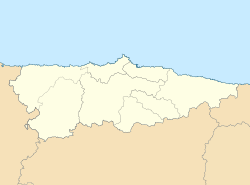San Antolín de Bedón (Llanes) facts for kids
Quick facts for kids San Antolín de Bedón |
|
|---|---|
|
Saint Antoninus of Bedón
|
|

An image of the church in 2008
|
|
| 43°26′17″N 4°52′09″W / 43.43806°N 4.86917°W | |
| Location | Llanes, Asturias |
| Country | Spain |
San Antolín de Bedón is an old church located in Llanes, a town in Asturias, Spain. It was built a long time ago, in the 13th century. The church stands close to the Monasterio de San Salvador in Celoriu. It's right by the mouth of the River Bedón, which splits the beautiful San Antolín beach into two parts.
This church was built in a special style called Cistercian. This means it has very few decorations. It looks simple and strong.
Contents
A Look at History
How the Church Began
The monastery was named after Saint Antolin of Apamea. He was a Christian who lived in the 4th century in a place called Syria. His special items, called relics, were kept in an abbey near Toulouse in France. People in medieval Spain started to honor him thanks to Bishop Ponce. Bishop Ponce was an advisor to King Sancho Garcés III of Pamplona.
The first mentions of this monastery are from the 12th century. These early records are from 1127, 1174, and 1176. However, the original papers are now lost. The first clear mention we have is from January 26, 1186. A man named Gonzalo Pérez and his son Martín González gave some land to the monastery of San Vicente in Oviedo. The leader of San Antolín, domno Iohanne abbate Sancti Antonini, confirmed this gift.
It was probably around the early 1200s when the monastery started following the Benedictine rule. This is a set of rules for monks. Work on the church began around this time. An old writing says that Abbot Juan started the building in 1205. Another writing from the same year is found at the front of the church.
The church's style is like Santa María de Valdediós. That church is near the monastery of the same name. However, Santa María de Valdediós was built a few years after San Antolín.
The monastery received many gifts from important people in Asturias. For example, Pedro Díaz de Nava left gifts in his will on April 9, 1289. Also, Rodrigo Álvarez de las Asturias, in his will from August 16, 1331, gave money for monks to pray for him.
Changes in the 1500s
In 1517, a very important person visited the monastery. This was Charles I, who later became a Holy Roman Emperor. He was traveling to Castile after being recognized as king by Pope Leo X. The abbot, Pedro de Posada, welcomed him on September 16, 1517. Three years later, in 1520, the king gave the abbot special permission. This allowed the abbot to set up a special family inheritance for his son.
In 1531, Pope Clement VII made an important decision. He ordered that the monastery join the San Benito group in Valladolid. This was because the monastery was in decline and needed help. Juan de Estella became the new abbot in 1532. But the monastery's problems continued. So, in 1544, the church was joined with the nearby monastery of San Salvador de Celoriu. This happened because the people and leaders of Llanes asked for it.
Later Years: 1800s and 1900s
Later, in the 1800s, the church was left empty. This happened after a time when the Spanish government took over church properties. The people living nearby moved their church services to Naves. They took important items like the main altar and the baptismal font with them. They even got permission in 1858 to tear down the church. They wanted to use its stones to fix another chapel in Naves.
However, a group called the Provincial Monuments Commission stepped in. They managed to save the church! The bishop then agreed to build a new church in Naves instead. He canceled the earlier permission to tear down San Antolín.
On June 4, 1931, the church was officially recognized as a "historical-artistic monument". Today, it is known as a Bien de Interés Cultural, which means it's a very important cultural site. A famous painter named Darío de Regoyos even painted the church. His painting is now in the Museum of Fine Arts of Asturias.
See also
 In Spanish: Iglesia de San Antolín de Bedón para niños
In Spanish: Iglesia de San Antolín de Bedón para niños
- Asturian art
- Catholic Church in Spain



